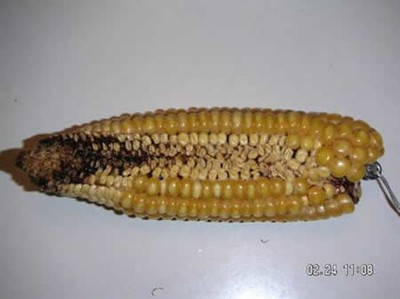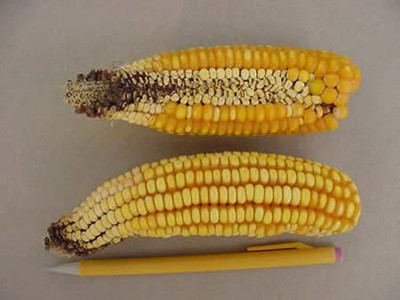 Source: P. Thomison, OSU |
 Source: P. Thomison, OSU |
The picture below shows a range of kernel development; silks are evident on one side of the ear, whereas kernels at the blister (R2) or milk stages (R3) stages in several rows while other kernels at the R3 stage.

These pictures show kernels at earlier stages of development (primarily blister stage) in 2 to 4 rows on one side of the ear whereas kernel in other rows are primarily at R3 . This differential developmental pattern suggests that the zippering problem is related to impaired pollination and kernel abortion


Close up of left ear view in above picture

“Zipper Ears” increase at higher seeding rates – 25,000, 35,000 and 45,000 seeds/A (left to right)
Symptoms:
Missing entire kernel rows or parts of kernel rows usually on the outside or underside of the ear primarily due to kernel abortion. Ears are often misshapen and bend (“banana” ears) due to differential kernel formation along the ear.
Causes:
Unknown. Because the lack of fill sometimes occurs when the affected part of the ear is facing downward, silks attached to these kernels may be covered up by other silks and simply do not get pollinated. Zippering is associated with severe drought stress, defoliation injury following pollination, and high plant population. Hybrids differ in their susceptibility to zipper ears especially when planted at high seeding rates.
Management:
Follow recommended guidelines for minimizing crop stress, including maintaining appropriate soil fertility, selecting adapted hybrids and seeding rates consistent for soil yield potential and date of planting. Avoid planting too early in wet soils and adjust planting depth with varying soil conditions. Minimize weed competition with effective herbicide application and/or timely cultivation.
References:
Abendroth, L. 2005. Examine corn ears now for clues to earlier stresses. Univ. of Nebraska Extension Crop Watch (September 16, 2005). Available at http://digitalcommons.unl.edu/cgi/viewcontent.cgi?article=1301&context=cropwatch [URL verified 10/7/2019].
Thomison, P.R. 2012 Corn ear abnormalities: “Tip dieback” and “zippering” C.O.R.N Newsletter 2012-29 (September 4, 2012 – September 11, 2012). Available at http://agcrops.osu.edu/newsletters/2012/29#4 [URL verified 10/7/2019].





